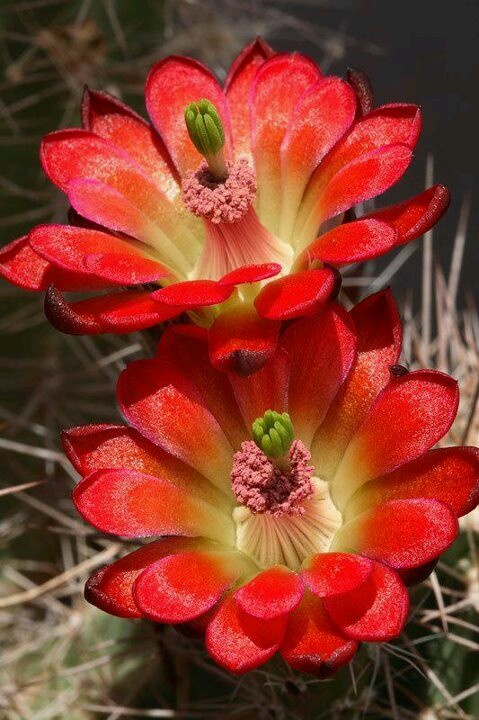The Claret Cup Cactus (Echinocereus triglochidiatus) is a striking cactus species known for its vibrant red flowers that bloom during the spring and summer months. Native to arid regions, this resilient cactus thrives in hot, dry climates and is especially well-suited for xeriscaping. Its unique appearance, with spiky exterior and beautiful blooms, makes it a favorite in both landscaping and gardening.
Key Features of the Claret Cup Cactus
- Flower Appearance: The Claret Cup Cactus is famous for its bright red flowers that appear during the warmer months. These flowers have a distinct shape, with pointed petals radiating out from a central core, creating a cup-like structure that adds vivid color to the landscape.
- Climate: The cactus thrives in hot, dry conditions, making it ideal for desert and xeriscape gardens. It can handle temperatures between 15°C to 35°C (59°F to 95°F), with minimal water requirements.
- Attracts Hummingbirds: The nectar-rich flowers are a favorite of hummingbirds, attracting these pollinators and adding life to your garden.
Growing Conditions for Claret Cup Cactus
- Temperature: The Claret Cup Cactus flourishes in hot temperatures and can withstand the extremes of desert climates. However, it is important to provide it with adequate protection from freezing temperatures.
- Watering: This cactus is extremely drought-tolerant, requiring minimal watering. Water the plant only when the soil is completely dry, and avoid overwatering to prevent root rot.
- Soil: Plant in well-draining soil to prevent water accumulation around the roots. A mix designed for cacti or succulents works best.
Care Tips for the Claret Cup Cactus
- Sunlight: The Claret Cup Cactus requires full sun for optimal growth. Plant it in a sunny location where it can receive plenty of light. This cactus will thrive in a dry garden or rock garden with excellent exposure to sunlight.
- Protection from Herbivores: Its spiky exterior provides natural protection from herbivores, but it’s still important to ensure that the cactus is not disturbed by larger animals that might try to nibble on the plant.
- Fertilization: The Claret Cup Cactus doesn’t need frequent fertilization. However, a light application of a balanced, low-nitrogen fertilizer during the growing season can encourage blooms.
Benefits of Growing Claret Cup Cactus
- Aesthetic Appeal: The Claret Cup Cactus is visually stunning, with its bold red flowers standing out in any garden. It provides a pop of color, especially in dry or desert-themed landscapes.
- Low Maintenance: Once established, this cactus requires minimal care, making it a great option for gardeners looking for a low-maintenance plant that still offers beauty and functionality.
- Pollinator-Friendly: By attracting hummingbirds, the Claret Cup Cactus plays a role in supporting local ecosystems and promoting biodiversity in your garden.
Conclusion
The Claret Cup Cactus (Echinocereus triglochidiatus) is a beautiful and resilient plant that adds both color and texture to arid gardens or xeriscapes. With its striking red blooms, minimal water needs, and full sun requirements, it’s an excellent choice for gardeners in hot, dry regions. Whether used in a rock garden, as part of a desert landscape, or simply as an ornamental plant, the Claret Cup Cactus is sure to thrive with the right care and attention. It’s a low-maintenance, high-reward plant that will bring life and beauty to any outdoor space.
